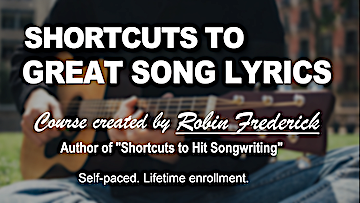Let’s say that you’ve decided to build a house. You’ve gathered a big pile of lumber and you’ve got a hammer and some nails. Good, that’s a start! But if that’s ALL you have, your house is probably going to end up looking very strange. Without a saw, a screwdriver, a level, and the rest of the homebuilder’s toolbox, your house will look very odd indeed. If you try to sell this house, most buyers won’t be interested. For some reason, they seem to like solid construction, square windows, and a door that works.
It’s the same with songs. Your ideas, creativity, and imagination are the raw material from which you’ll build your song. But if you don’t have all the tools you need, your song is likely to end up sounding odd or uninteresting or so strange that listeners can’t find their way in. Songwriting tools can help you create a song that works for listeners, helping them feel the emotion, understand the situation, and identify with the singer. At the same time, the raw material you start with will ensure that the song is YOUR song and expresses what YOU feel. So put on your hard hat and assemble your songwriting tools.
USE A SONG STRUCTURE
You wouldn’t build a house without a blueprint, so don’t build a song without a clear plan for the structure. The vast majority of today’s hit songs feature a verse and chorus structure that looks something like this: Verse / Chorus / Verse / Chorus / Bridge / Chorus. Listeners like this structure; it has enough variety to keep them interested and enough repetition to make them feel comfortable. Using this structure won’t make you sound like everyone else because you’re going to fill it in with YOUR thoughts and YOUR inspiration.
USE IMAGES AND DETAILS TO COMMUNICATE THE SITUATION
Instead of saying “I remember that night,” try to show your listeners that night! They weren’t there. They don’t know anything about it. Let your listeners be inside the scene by telling them what the surroundings looked like, who was there, what they did, what they looked like. Choose those details that sum up the essence of what happened and the feelings that were going on.
UNDERSCORE YOUR LYRIC WITH YOUR MELODY
Think of your melody like the music underneath a scene in a movie. Watch a few films with big scores, like <em>Titanic</em>, Notice how the music rises when the emotion intensifies. Now try something similar in your song. When you get to your chorus, which is where the big emotions in a song are often focused, try a melody line that slowly rises or suddenly leaps tgo a high note or changes pace.
These are just three tools you can use; there are dozens more (126 in my book “Shortcuts to HIt Songwriting”). But this isn’t about memorizing or parroting some rules! Pick a couple of these ideas and and go write a song using them. Just as a builder uses some tools every day and others only occasionally, there are some songwriting tools you will use more than others.
When we listen to songs, they seem somehow magical and effortless. It’s easy to forget that in addition to inspiration and emotion, it takes knowledge and hard work to build an effective song — the kind listeners will want to “move into.” So put on your hard hat, assemble your tools, look at your ideas as raw material, and get started!
